Basically, each sample needs to be evaluated for it's actual PERFORMANCE in the hands of a spinner. The resulting yarn quality will be evaluated in the final step.
Tools of the trade: The spinning wheel. Now, any wheel can work, but this is my preference. I
 use an Ashford Elizabeth 2 Saxony style wheel set on single drive with Scotch tension. The reason I like this wheel in particular is that it has so many possible variations. It can be used double drive, single drive with Scotch tension (pictured), or direct drive. I choose SD with Scotch tension for this application because it allows me to fine tune and fine FEEL what is happening in the fiber. It also allows me to very quickly remove the tension completely so that I can wind the skeins.
use an Ashford Elizabeth 2 Saxony style wheel set on single drive with Scotch tension. The reason I like this wheel in particular is that it has so many possible variations. It can be used double drive, single drive with Scotch tension (pictured), or direct drive. I choose SD with Scotch tension for this application because it allows me to fine tune and fine FEEL what is happening in the fiber. It also allows me to very quickly remove the tension completely so that I can wind the skeins. Other tools: A small niddy noddy to wind the 4-5 yard lengths into a practical skein for evaluation. Pencil and score sheet obviously. The "flicker brush" is ESSENTIAL to this process. 10 points is assigned to 'preparation of fiber'.
Some people have used a mechanical drum carder to prepare the samples for Spin Off. The first problem here is that it takes at least an ounce of fiber to properly card on a drum carder. I don't NEED to actually work that much fiber in order to judge it adequately so anything over a handful processed is wasted. As far as I'm concerned, the person sending the sample deserves the assumption that their fiber is valuable and should not be treated wastefully. I am not going to spin a full ounce of fiber just because I already carded it and it is plain out WRONG to waste that fiber. The second problem is that you simply cannot compare how one fiber drum cards to how another drum cards. The drum is intended to make ALL fiber easier to work. There simply is no judgement to the process. Alpaca is known for needing minimal processing for use and that means flicking.
The last tool in the photo might be my hand but in reality, it's what is ON my hand; namely the bracelet. I find it essential to my process but that is better shown than explained.
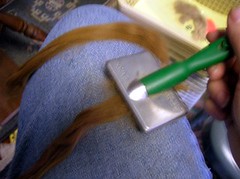
Flicking. The flicker - yes, it is a cheap cat slicker brush and it's served me well for the $3.50 I spent on it 4 or 5 years ago - is bounced, not dragged, over the ends of the fiber. This serves to simply open up the fibers. On really long staples like the suri pictured it takes a patient effort to work from the end to the middle of the staple without breaking and losing the fiber. Fiber that is brittle or tender won't stand the process and ends up wasted. How well the fiber opens up and the amount of loss contribute to the score. I give every staple 3 taps per end. More than that and the points start decreasing. Extremely long fiber may well lose points here, but may gain them right back in the spinning and as a fine yarn later.
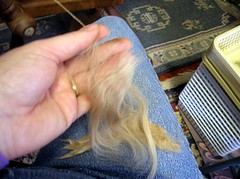
Drafting is an important part of how the fiber is scored for spinning. The best fiber is one that is not so slippery as to resist twist but no so tacky as to resist drafting. A great fiber lends itself to any type of draft I choose; short draw, long draw, spinning from the fold or novelties like slub or boucle. Huacaya fiber almost always drafts evenly from the cut or tip end but suri often spins well only from the tip. Basically, the more the fiber allows me to do, the better it is and the higher the score.
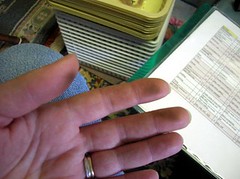
This is an example of what you do NOT want your fiber to do! This fiber was so covered in a black (?!) substance that my hands were covered after spinning just a small handful. The fiber was very sticky and required a lot of work to keep it reasonably smooth and even. This fleece would require washing before any preparation could be done. It's unpleasant and un-versatile. That equals a very poor impression on the customer and a very poor score for the fiber.

And here is my personal secret to success. After the fiber is spun into a single strand, the tension is released completely and the strand is drawn back out through the orifice. I catch the end of the strand under my bracelet (if I lose that end, I'm skunked!) and then wind the strand around my hand into an Andean bracelet.
Once I reach the far end of the strand, I release the bracelet, meet the near and far ends of the strand (
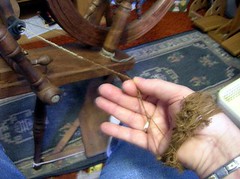 effectively folding the strand in half) and then ply the two ends together into a 2 ply yarn. The strand never leaves the bobbin.
effectively folding the strand in half) and then ply the two ends together into a 2 ply yarn. The strand never leaves the bobbin. 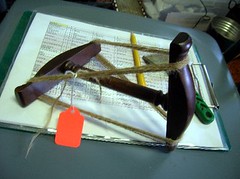 The plied yarn is wound on a Niddy to make one large loop of yarn.
The plied yarn is wound on a Niddy to make one large loop of yarn. 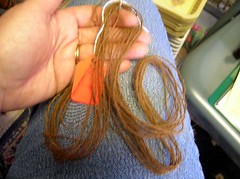
The plied yarn skein can be evaluated for it's performance right off the niddy. Does it balance easily and allow it to lay (lie?) relaxed? Does the fiber resist twist causing slubs and excessive barbing of the fiber?
The next step will be to wash the skeins and then evaluate the finished yarns. The photos of that might take a few days since I can't for the life of me find my battery charger. It's here someplace.
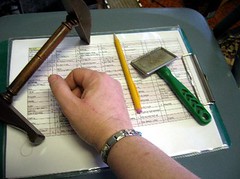
1 comment:
Just reading about it makes me want to learn to spin. You are such an enabler - or maybe even a pusher! Know anywhere I can get some decent roving and a drop spindle? (grin)
Post a Comment